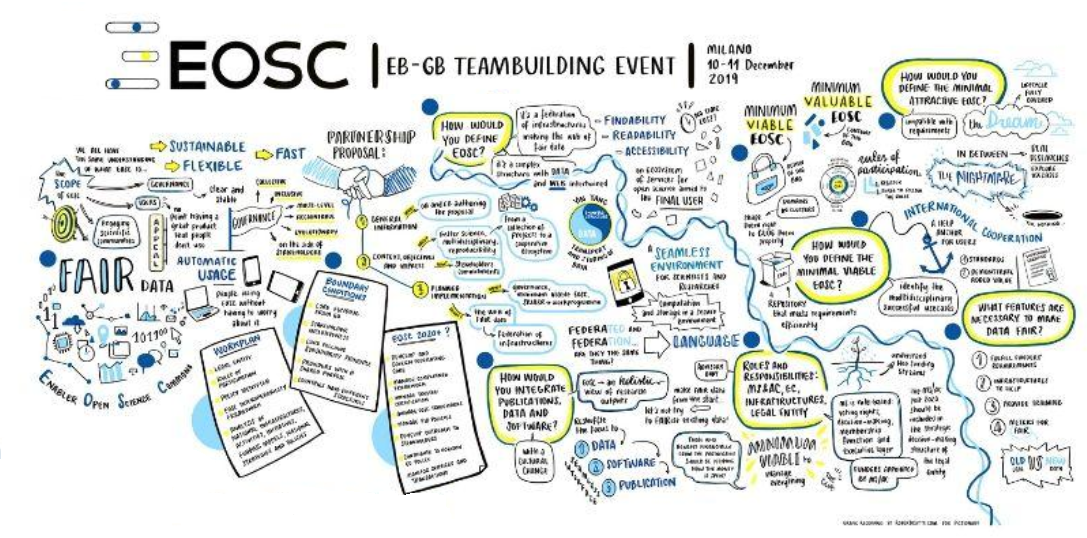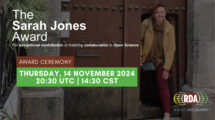First things first: we now have a “in principle” agreement on the Horizon Europe candidate Partnership Proposal for EOSC. This is excellent news as the formation of a strategic partnership for EOSC beyond 2020 means that the governance and executive boards are delivering increased stability for EOSC activities under Horizon Europe. It means that an activity that was mainly Horizon 2020 project-led over the last years, now receives the full support from EU Member States and Associate Countries. In short, we have taken EOSC to its next level!
But I should give you a little bit more background: following from our first joint EOSC Governance and Executive Board meeting in Munich back in May this year, we met again on 10 and 11 December in Milan. The event was supported by the EOSC Secretariat project, and overall attended by 23 representatives of 18 Member States and Associate Countries, 8 representatives of the EU (DG-RTD and DG-CNCT), as well as 9 Executive Board members. As I indicated already above the main item on our agenda for the two days was the discussion on the Horizon Europe Candidate Partnership Proposal, which was circulated in its second version, following the first round of discussions earlier in November this year.
The wonderful thing was, that we also had an artist in the room while we were talking – he produced a most amazing mindmap of our discussions – you can find this drawing here: https://www.eoscsecretariat.eu/sites/default/files/eosc_milan_meeting_mindmap_0.jpg What an amazing way to summarise a working meeting!
And for those who like words: The main discussion during the Milan event focused on the question what set of services are core to operating EOSC, which services would be part of the wider EOSC eco-system and could we agree on how to call this. As you know, we have generally been referring to “federating core” or “EOSC core” and we often hear also references to terms like minimal viable product or minimal viable EOSC and its ecosystem. In Milan, the additional distinction was drawn between the Minimum Viable EOSC and the Minimum Valuable EOSC. Those of you, who have been following EOSC for many years now will share a level of frustration here, but I think it has to be realised that the transition from EOSC as a set of project based activities to a stable Strategic Partnership under Horizon Europe and with Member State and Associate Country commitment requires these discussions, to ensure a common understanding between all partners. The difference is that a Minimal Viable EOSC consists of core infrastructures and services needed to operate EOSC and a Minimal Valuable EOSC consists of additional value-added infrastructures and services. As Jean-François Abramatic put it: “if you can take it away and nothing happens, it is not in the core”.
We also discussed the benefits and commitments to/from Member States and Associate Countries. Here Member States and Associate Countries noted specifically that EOSC will not only lead to scientific breakthroughs for society but will also be facilitating the transition to national Open Science frameworks, thus becoming a game-changer for the research incentives and rewards systems. Specific commitments are of course closely linked to the Strategic Partnership for EOSC, but need to include adhering to rules of participation of EOSC, supporting data management plans and Open Data, and deploying FAIR data and services via existing infrastructures.
And we also went in detail into the proposed creation of a legal entity, which would need to be established for the Horizon Europe Strategic Partnership. One important statement needs to be made here: The EOSC as a legal entity is not the same as the future EOSC-ecosystem. This Legal Entity, in addition to operating various parts of EOSC technical infrastructure, will have as an important task to establish the future ESOC association which will have a major role in driving the future of EOSC ecosystem. The legal entity will thus be involved in governing, developing, sustaining and communicating EOSC.
The final discussions were around the workplan for 2020 – there is an enormous amount of work coming up for the EOSC Governance Boards – from the key strategic documents for 2020 which include the studies on landscape, sustainability, legal entities, and EOSC readiness in Member States and Associate Countries as well as the documents necessary to follow through with the Strategic Partnership such as the finalisation of the partnership proposal itself, the articles of association for the legal entity, the MoU relating to the strategic partnership and outline Strategic Research and Innovation Agenda which will need to be ready to feed into the Horizon Europe work plan. It will be a busy year!
Key implementation topics for 2020 include rules of participation, catalogue of data and services, PID policies, metrics and certification, Minimal Viable EOSC, interoperability framework, and EOSC events, such as the EOSC Symposium, which will take place in Q4, 2020 and will bring the work of the Governance and Executive Board to a conclusion.
But as we know, every journey simply consists of the next step, so for us, this meant that we all said good-bye to each other on the Wednesday, knowing that we would meet again for the Governance Board meeting on 16 December in Brussels. That was also a very positive meeting and brings me back to my initial paragraph – we have taken EOSC to the next level!
Thanks for reading!
Join the EOSC Secretariat network now and get updates like this straight in your inbox!







